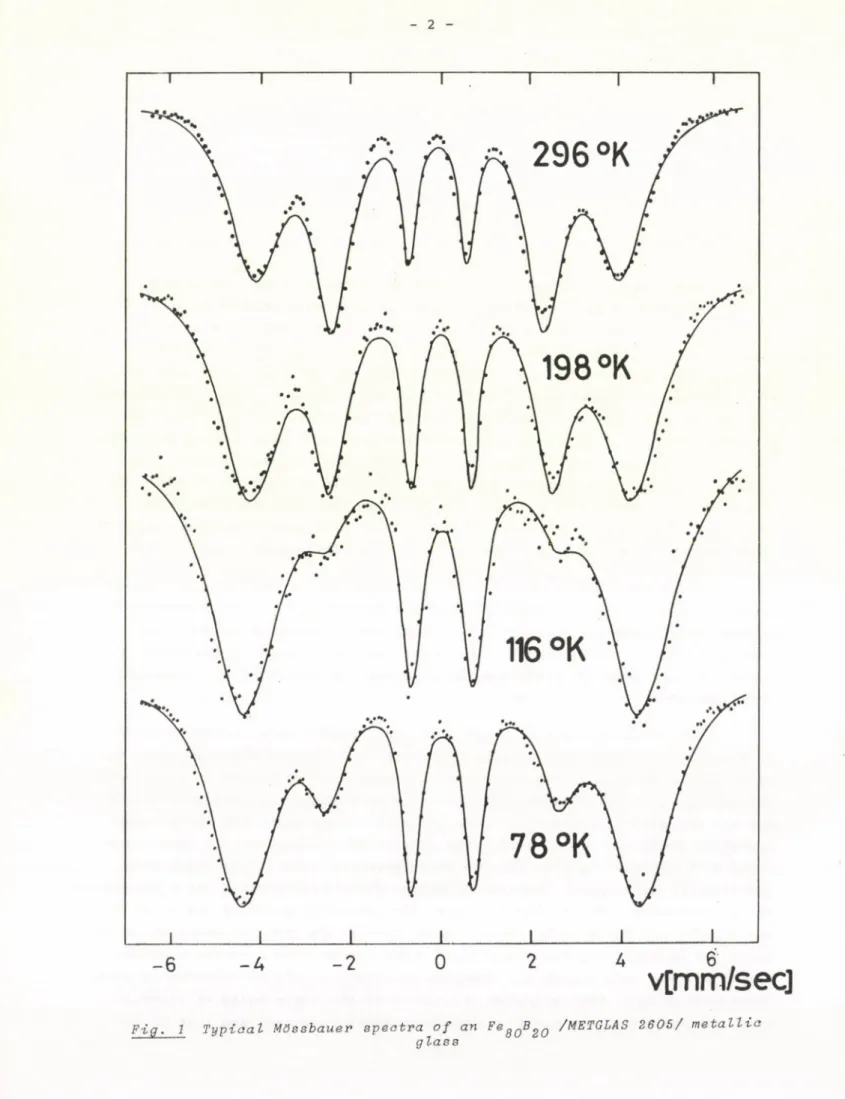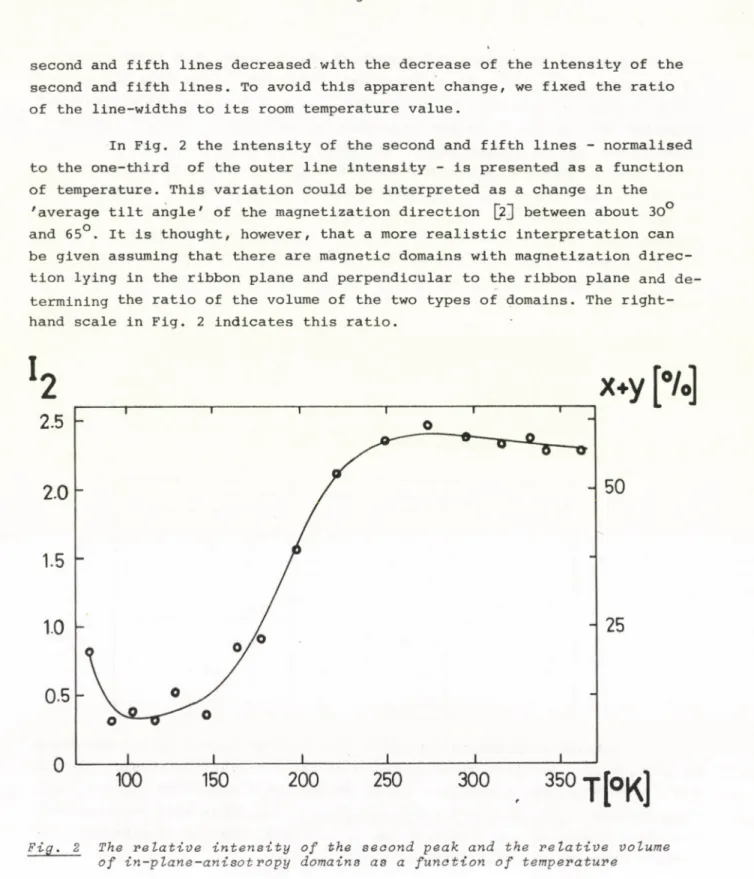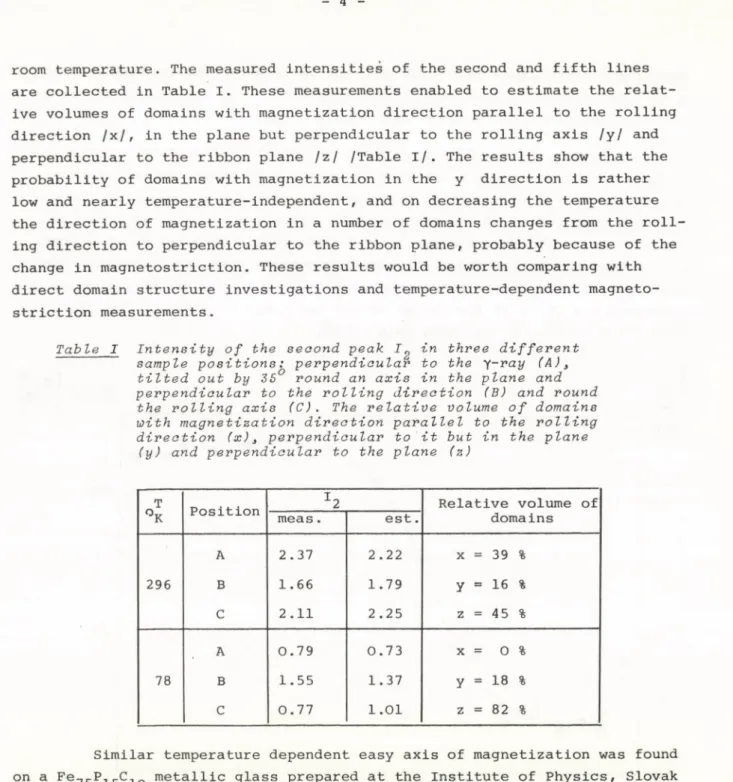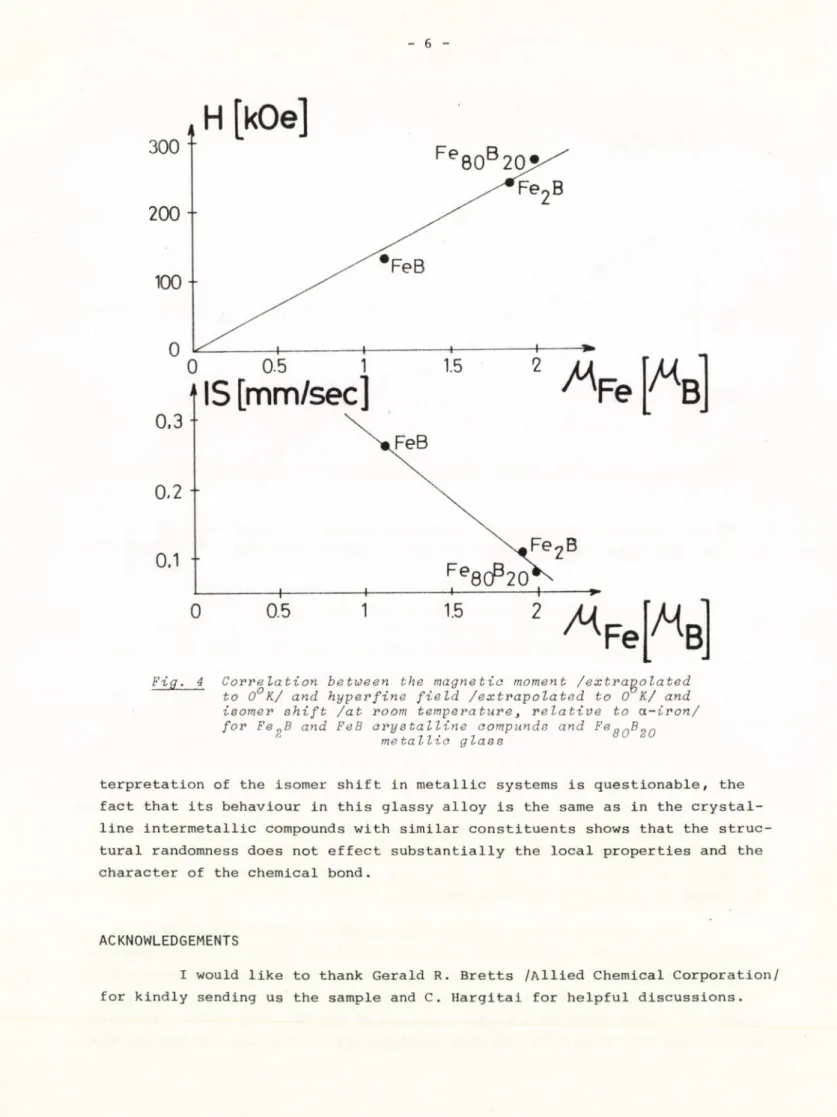--1J
7 -fC t5ő-.c>2£~
KFKI-76-36
L, T A K Á C S
MÖSSBAUER INVESTIGATION OF THE MAGNETIC A N I S O T R O P Y AND ELECTRONIC STRUCTURE OF A METALLIC GLASS
H u n g a ria n Academ y o f S cien ces
CENTRAL RESEARCH
INSTITUTE FOR PHYSICS
BUDAPEST
KFKI-76-36
MÖSSBAUER INVESTIGATION OF THE MAGNETIC ANISOTROPY AND ELECTRONIC STRUCTURE OF A METALLIC GLASS
L. Takács
Solid State Physics Division
Central Research Institute for Physics, Budapest, Hungary
Submitted to Solid State Communications
ISBN 963 371 144 4
ABSTRACT
The magnetic anisotropy of a Fe~ В /METGLAE 2605/ metallic glass has been investigated by Mössbauerspectroscopy. The direction of magnetization,is shown to be strongly temperature dependent with an un
usually large out-of-plane component. The similarities between the elec
tronic structure of this glassy alloy and the Fe2® an<3 FeB intermetallic compounds are discussed briefly.
АННОТАЦИЯ
С помощью эффекта Мессбауэра изучалась магнитная анизотропия аморфного сплава F e R В /METGLAS 2605/. Обнаружено, что направления легкого намагничивания сильно зависит от температуры. Получено также необходимо большое значение перпендикулярной составляющей намагничива
ния по отношению к поверхности фольги. Кратко излагается сходство элект
ронной структуры аморфного сплава Feg0 &2о и интеРметаллического соеди
нения Fe2Ö и FeB.
KIVONAT
Mössbauer spektroszkópia segítségével vizsgáltuk a Feg0 B_
/METGLAS 2605/ fémüveg mágneses anizotrópiáját. Megmutattuk, hogy a köny- nyü mágnesezési irány erősen hőmérsékletfüggő és a fólia sikjára merőle
ges komponens szokatlanul nagy. Röviden taglaljuk e fémüveg és a Fe_B és FeB intermetallikus vegyületek elektronszerkezete közötti hasonlóságot.
Since the intensity ratio of the six lines in a Fe Mössbauer spectrum depends on the direction of magnetization with respect to the y-ray direction, Mössbauer effect can be used for studying the magnetic anisotropy and domain structure of metallic glasses. The first result of this type was obtained by Tsuei, Longworth and Lin QlJ , who found that the easy direction of magnetization of an as-quenched Feg0P i 2 5C 7 5 9lassY alloy lied in the ribbon-plane /the intensity ratio being 3:4:1:1:4:3/ but after annealing the intensity ratio became 3:2:1:1:2:3, indicating a random orien
tation of magnetic domains. More recently Chien and Hasegawa observed that the magnetization direction of a F e ^ N i ^ P ^ B g /Allied Chemical METGLAS 2826/
metallic glass sample was strongly dependent on the temperature between 240°K and 77°K first tilting out of the ribbon plane with a maximum angle of about 45° at 110°K and tilting back toward:-: the ribbon plane below 110°K [2] .
This paper deals with a similar example for the temperature depend
ence of the average magnetization direction in an FegQB 20 Chemical METGLAS 2605/ glassy alloy, but with a much more pronounced out-of-plane component. In the second part of the paper the similarities between the prop
erties of this metallic glass and the and FeB intermetallic compounds are discussed.
Mössbauer spectra of a glassy FegQB2o samPle were recorded between 77°K and 363°K using a conventional constant-acceleration Mössbauer spectro- meter with a 10 mCi Co 57 in Pd source. The data were collected in a 1024-chan
nel analyser. In Fig. 1 some typical Mössbauer spectra are presented. Since our aim was only to study the intensity ratio of the peaks and the average hyperfine field and isomer shift, the spectra were fitted to six Lorentzian lines with different widths for the three pairs of lines. This evaluation
involves the presumption that the hyperfine field distribution has a Lorentzian shape. Of course, this is not the case. The intensity ratio of the outer and inner peaks was found to be about 3:0.75, indicating that the overlapping be
tween the neighbouring lines may cause systematical errors in the line-in- tensities. For this reason the obtained results can only be regarded as semi- quantitative ones. When allowing the widths of the three pairs of lines to vary independently, the width of the outer peaks increased and that of the
57
2
Fig. 1 Typical Mőssbauer spectra of an Fefír)B 9n /METGLAS 2605/ metallic glass
3
second and fifth lines decreased with the decrease of the intensity of the second and fifth lines. To avoid this apparent change, we fixed the ratio of the line-widths to its room temperature value.
In Fig. 2 the intensity of the second and fifth lines - normalised to the one-third of the outer line intensity - is presented as a function of temperature. This variation could be interpreted as a change in the
'average tilt angle' of the magnetization direction [2] between about 30°
and 65°. It is thought, however, that a more realistic interpretation can be given assuming that there are magnetic domains with magnetization direc
tion lying in the ribbon plane and perpendicular to the ribbon plane and de
termining the ratio of the volume of the two types of domains. The right- hand scale in Fig. 2 indicates this ratio.
Fig. 2 The relative intensity of the second peak and the relative volume of in-plane-anisotropy domains as a function of temperature
To control this interpretation the sample was turned out from its perpendicular-to-the-y-ray direction with an angle of 35° round the rolling direction and round an axis perpendicular to it but lying in the ribbon plane and Mössbauer spectra were taken in such geometries at liquid nitrogen and
4
room temperature. The measured intensities of the second and fifth lines are collected in Table I. These measurements enabled to estimate the relat
ive volumes of domains with magnetization direction parallel to the rolling direction /х/, in the plane but perpendicular to the rolling axis /у/ and perpendicular to the ribbon plane /z / /Table I/. The results show that the probability of domains with magnetization in the у direction is rather low and nearly temperature-independent, and on decreasing the temperature the direction of magnetization in a number of domains changes from the roll
ing direction to perpendicular to the ribbon plane, probably because of the change in magnetostriction. These results would be worth comparing with direct domain structure investigations and temperature-dependent magneto
striction measurements.
Table I Intensity of the second peak I^ in three different sample positions: perpendicular to the у-ray (A), tilted out by 35° round an axis in the plane and perpendicular to the rolling direction (B) and round
the rolling axis (C). The relative volume of domains with magnetization direction parallel to the rolling direction (x), perpendicular to it but in the plane
(y) and perpendicular to the plane (s)
T
°K Position *2 Relative volume of
domains meas . e s t .
A 2.37 2.22 x = 39 %
296 В 1.66 1.79 у = 16 %
C 2.11 2.25 z = 45 %
A 0.79 0.73 x = 0 %
78 В 1.55 1.37 у = 18 %
C 0.77 1.01 z = 82 %
Similar temperature dependent easy axis of magnetization was found on a Fe75Pi5C io metallic glass prepared at the Institute of Physics, Slovak Academy of Sciences, Bratislava and on METGLAS 2615 and 2826B ribbons /with compositions FegoP i6B lC 3 and Fe2gN.i4g P j ^BgS^ / [2]. Thus this temperature dependent magnetization direction may be a general feature of metallic glasses prepared by 'mill devices'.
As it is expected for metallic glasses, the T 3/2 law of the temper
ature dependence of the hyperfine field is valid up to a rather high temper
ature /Fig. 3/, large deviations occur above room temperature only. The aver age hyperfine field extrapolated to 0°K is 276+2 kOe. The width of the hyper fine field distribution is about 75 kOe estimated from the line-widths.
5
In metallic iron the hyperfine field is the sum of the core polariza
tion and conduction electron polarization contributions Q3l . It has been shown, however, that in the Fe2B and FeB /and some other/ intermetallic com
pounds the 3d electrons are much more localised and the conduction electron polarization can be neglected [_4j . The ratio of the hyperfine field and the magnetic moment in the investigated FegQB2o metallic glass | 5~| is the same as that in the intermetallic compounds mentioned /Fig. 4/. Thus we expect that the decrease in the metalloid content which is necessary to the formation of the glassy state, is compensated by the structural randomness of the glass.
This random arrangement of atoms will enhence the localisation of the electron
ic states, allowing the magnetic moment in the glassy alloy to be almost as localised as in an intermetallic compound.
The magnetic moment of these intermetallic compounds and metallic glasses is generally explained in terms of the donor model. In this model the interaction between the transition metal and metalloid results in an electron transfer from the metalloid to the metal 3d band. In accordance with this model the isomer shift is a linear function of the magnetic moment [4^ . This systematics will also hold for this metallic glass. Although the precise in-
3 / 2
F i g. 3 T ' dependence of the average hyper fine field
6
Fig. 4 Correlation between the magnetic moment /extrapolated to OvК/ and hyper fine field /extrapolated to О К/ and isomer shift /at room temperature, relative to a-iron/
for Fe„B and FeB crystalline aompunds and FefínB 9n metallic glass
terpretation of the isomer shift in metallic systems is questionable, the fact that its behaviour in this glassy alloy is the same as in the crystal
line intermetallic compounds with similar constituents shows that the struc
tural randomness does not effect substantially the local properties and the character of the chemical bond.
ACKNOWLEDGEMENTS
I would like to thank Gerald R. Bretts /Allied Chemical Corporation/
for kindly sending us the sample and C. Hargitai for helpful discussions.
7
REFERENCES
[lj Tsuei C.C., Longworth G. and Lin S.C.H., Phys. Rev. 170, 603 /1968/
И Chien C.L. and Hasegawa R., J. A p p l . Phys. £7, 2234 /1976/
[3] Vincze I. and Campbell I.A., J. Phys. F.: Metal Phys. 3, 647 /1973/
[4] Vincze I., Cadeville M.C., Jesser R. and Takács L., J. Phys. 3 5 , C6-533 /1974/
[5] The magnetic moment is 1.99 yß /Fe atom. Allied Chemical Preliminary Data Sheet 12/23/75
Kiadja a Központi Fizikai Kutató Intézet Felelős kiadó: Kosa Somogyi István, a KFKI Szilárdtestkutatási Tudományos Tanácsának szekcióelnöke
Szakmai lektor: Hargitai Csaba Nyelvi lektor : M. Kontsag Judit Példányszám: 295 Törzsszám: 76-561 Készült a KFKI sokszorosító üzemében Budapest, 1976. junius hó



